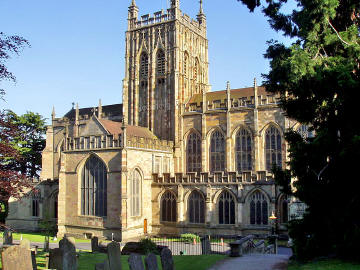Malvern Priory
Great Malvern, Worcestershire
|

Location Guide |
|
Great Malvern priory was built initially by 30
monks, work began in 1085 as the Priory of St Mary. It was connected with
Westminster abbey. It was connected with the Benedictine order. Later expanded
and rebuilt.
The present building dates from 1085, with mainly 15th century structure,
floor, and wall tiles. The original Norman architecture church was extended in
the years between 1450 and 1500. The great square central tower is very similar
to that of Gloucester Cathedral, it was built by the same masons. It
was redesigned in Perpendicular style by Sir Reginald Bray) and has a very plain
interior. The chancel is also Perpendicular in style, and contains the monument
of John Knotsford (died 1589), a participant in the dissolution of the former
monastic foundation. It is largely thanks to his patronage that the church, and
particularly its medieval glass, survived so well.
|

Image from Wikipedia

 Click the image to see a larger version
Click the image to see a larger version |
The fine collection of stained glass ranges from medieval to modern, and
includes 15th century and 19th century windows. The north transept window,
depicting the Coronation of St. Mary, was a gift from Henry VII in 1501, and
another from the Duke of Gloucester, later Richard III. A careful restoration
was carried out in 1860 under the direction of Sir George Gilbert Scott, the
famous architect, who also designed the roof of the nave in imitation of the
medieval original.
History
During the reign of Edward the Confessor, Saint Wulfstan, the Bishop of
Worcester, encouraged a hermit named Aldwyn to found a monastery in what was
then the wilderness of Malvern Chase. According to the Worcester Monastic Annals
this work began in 1085. The Priory was built for thirty monks on land belonging
to Westminster Abbey. A charter from Henry I in 1128 AD refers to Great Malvern
Priory as 'the Priory of St. Mary'. In 1154–1156, Westminster Abbey obtained a
Papal bull from Pope Adrian IV which confirms a strong dependency of the priory
of St Mary, Malvern, on the Abbey of Westminster.
Having allegiance to Westminster Abbey, there were altercations between the
Priory and the Bishop of Worcester over the years. It is reported that in 1286
the Archbishop, the King and even the Pope were involved in these disagreements.
The Norman church was extended in the years between 1440 and 1500. The
tower is very similar to that of Gloucester Cathedral and was built by the
same masons.
Bishop John Carpenter, Bishop of Worcester, on July 30th 1460
dedicated the rebuilt priory church and some 12 altars, he referred, at the High
Altar, to the patrons as "the Blessed Virgin Mary and St Michael the Archangel",
together with St John the Evangelist, St Peter, St Paul, and also St Benedict,
founder of the Order. Today the priory is known as the Parish Church of St Mary
and St Michael.
At the dissolution of the monasteries in the time of Henry VIII, the Priory
church was saved by the parishioners of Malvern. Their own tiny parish church
was derelict. It stood where the main Malvern post office is now. The
parishioners petitioned the King and succeeded in buying the Priory for £20. It
took them two years to raise the money. The parish consisted of only 105
families and after they had bought the church they had no money left to carry
out repairs.
The Civil War largely passed it by. It wasn't until the mid 1800's that
repair work was seriously undertaken, with some additions and other
refurbishment. During World War II the stained glass was removed and stored in
zinc lined boxes which aided their preservation. After the war Dr L.A. Hamand,
the organist, painstakingly replaced the stained glass windows in their original
positions as far as was possible.
Their own website gives a fuller
history see link below.
|
Location: Malvern Priory, Great Malvern,
Worcestershire |
|
Grid Reference:
SO775457 |
Ceremonial County:
Worcestershire
 |
|
Map Link:
StreetMap

|
Aerial photo:
Google Aerial
 |
|
Getting there: in Malvern, see map |
|
Access: May be off another road at the north
side of the priory. |
Website:
Own  detailed history
detailed history
 |
Other Useful Websites:
Wiki
 |
|
Email:
office@greatmalvernpriory.org.uk |
|
Address:
Malvern Priory, Parish Office, Church Street, MALVERN |
|
Postcode:
WR14 2AY |
Telephone:
01684 561020
Parish Office is open Weekdays 9am to 12 noon |
|
Opening Times: Not specified on their website,
call them if travelling from very far. |
|
Charges: None specified, I don't expect there
are any |
|
Nearby Locations: Malvern Hills |
|
Other Location Pages:
List of all Anglican
cathedrals and other major Anglican churches in the UK

Abbey
section,
 including all major Christian buildings, regions orders, normal layouts and
history.
including all major Christian buildings, regions orders, normal layouts and
history. |
|
Notes:
|
|

|
Please let us know any other information that we
can add to the Grid(s) or page and any errors that you discover. Before making a long trip to any location it is always
wise to double check the current information, websites like magazines may be
correct at the time the information is written, but things change and it is of
course impossible to double check all entries on a regular basis. If you have
any good photographs that you feel would improve the illustration of this page
then please let us have copies. In referring to this page it is helpful if you
quote both the Page Ref and Topic or Section references from the Grid below. To print the
planning grid select it then right click and print the selected area.
Please submit information on locations you discover so
that this system continues to grow.
|